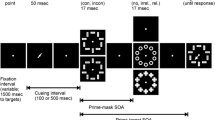Abstract
In a previous study, the sensory phenomenon of “backward masking” was used to demonstrate that subjects can preprogram a single stereotyped voluntary movement or movement-sequence and that such a movement can be triggered in response to a stimulus that is not perceived (that is, a stimulus of which the subject is unaware). In the present study, visual stimuli were presented at random in one of two different locations to normal human subjects in a choice reaction-time (RT) task. When the stimulus appeared in one of the locations, subjects made a motor response. When the stimulus appeared in the other location, subjects made a different motor response. Large and small stimuli were presented in either location. In some trials, the small stimulus was followed 50 ms later by the large stimulus. The small stimulus was then “masked” by the large stimulus and could not be perceived on forced-choice testing. Despite not perceiving the test stimulus in either of its randomly selected locations, subjects were able to select and execute the motor response appropriate for each location. The RTs for responses to the masked stimulus and to the same stimulus presented without masking (and so, easily perceived) were the same. This result implies that appropriate programs for two separate movements can be simultaneously held ready for use, and that either one can be executed when triggered by specific stimuli without subjective awareness of such stimuli and so without further voluntary elaboration in response to such awareness.
Similar content being viewed by others
References
Alpern M (1953) Metacontrast. J Opt Soc Am 43:648–657
Breitmeyer BG (1984) Visual masking: an integrative approach. Oxford University Press, New York
Day BL, Rothwell JC, Thompson PD, Maertens-de-Noordhout A, Nakashima K, Shannon K, Marsden CD (1989) Delay in the execution of voluntary movement by electrical or magnetic brain stimulation in intact man. Brain 112:649–663
Fehrer E, Biederman I (1962) A comparison of reaction time and verbal report in the detection of masked stimuli. J Exp Psychol 64:126–130
Fehrer E, Raab D (1962) Reaction time to stimuli masked by metacontrast. J Exp Psychol 63:143–147
Harrison K, Fox R (1966) Replication of reaction time to stimuli masked by metacontrast. J Exp Psychol 71:162–163
Hasbroucq T, Guiard Y (1991) Stimulus-response compatibility and the Simon effect: toward a conceptual clarification. J Exp Psychol Hum Percept Perform 17:246–266
Klapp ST (1981) Motor programming is not the only process which can influence RT: some thoughts on the Marteniuk and MacKenzie analysis. J Mot Behav 13:320–328
Klapp ST, Wyatt EP, Lingo WM (1974) Response programming in simple and choice reactions. J Mot Behav 6:263–271
Klapp ST, Greim DM, Marshburn EA (1981) Buffer storage of programmed articulation and articulatory loop: two names for the same mechanism or two distinct components of short-term memory? In: Lang J, Baddeley A (eds) Attention and performance IX. Erlbaum, Hillsdale, NJ
Kornblum S, Hasbroucq T, Osman A (1990) Dimensional overlap: cognitive basis for stimulus-response compatibility — a model and taxonomy. Psychol Rev 97:253–270
MacKay WA, Bonnet M (1990) CNV, stretch reflex and reaction time correlates of preparation for movement direction and force. Electroencephalogr Clin Neurophysiol 76:47–62
Raab DH (1963) Backward masking. Psychol Bull 60:118–129
Rosenbaum DA (1980) Human movement initiation: specification of arm, direction and extent. J Exp Psychol Gen 109:444–474
Schiller PH, Smith MC (1966) Detection in metacontrast. J Exp Psychol 71:32–39
Sheridan MR (1981) Response programming and reaction time. J Mot Behav 13:161–176
Simon JR, Rudell AP (1967) Auditory S-R compatibility: the effect of an irrelevant directional cue on information processing. J Appl Psychol 51:300–304
Taylor JL, McCloskey DI (1990) Triggering of preprogrammed movements as reactions to masked stimuli. J Neurophysiol 63:439–445
Author information
Authors and Affiliations
Rights and permissions
About this article
Cite this article
Taylor, J.L., McCloskey, D.I. Selection of motor responses on the basis of unperceived stimuli. Exp Brain Res 110, 62–66 (1996). https://doi.org/10.1007/BF00241375
Received:
Accepted:
Issue Date:
DOI: https://doi.org/10.1007/BF00241375




